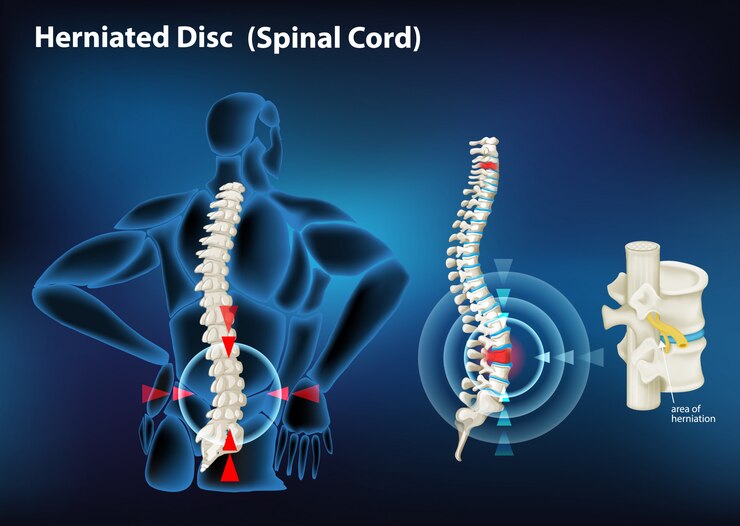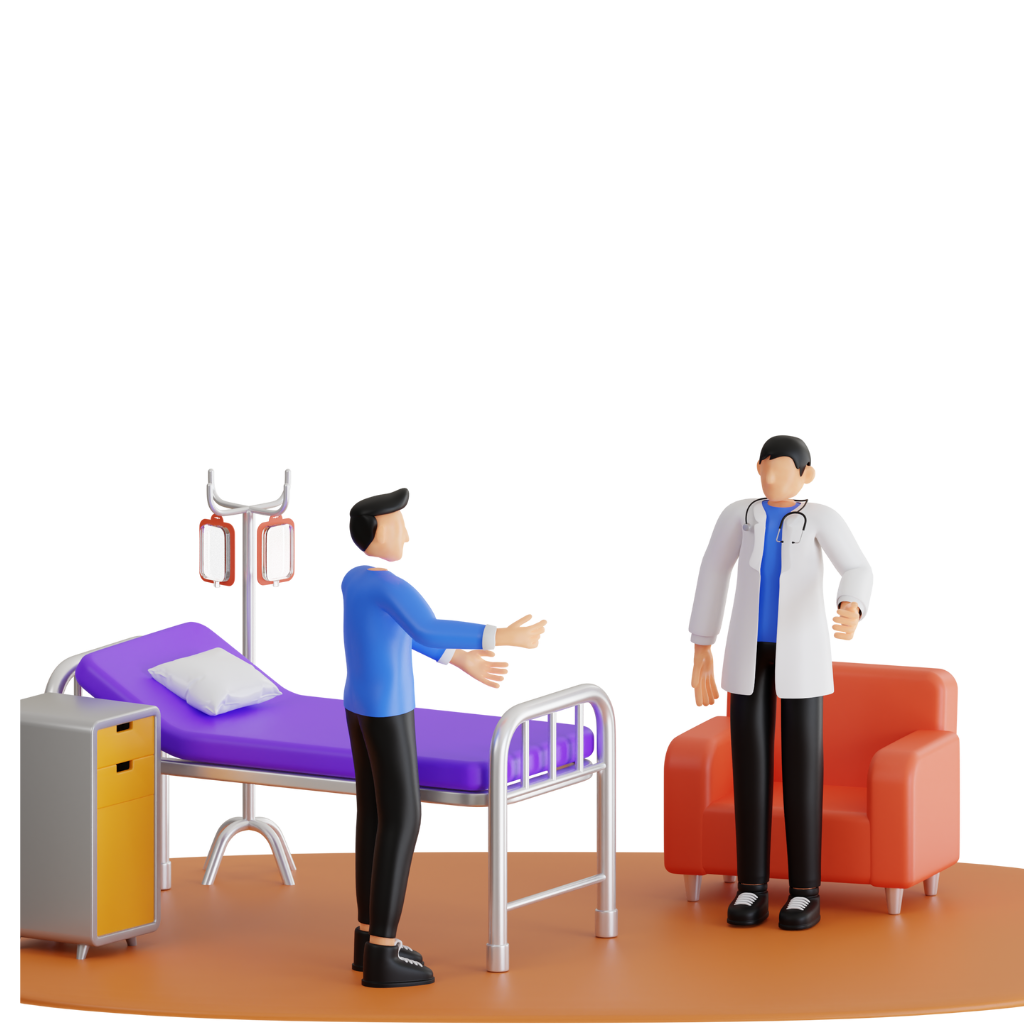Herniated Disc Surgery
Home >> Spine Surgery Services >> Herniated Disc Surgery
Herniated Disc Surgery
Dr. Mahesh Prasad, a specialist in Disc Herniation treatment, is aware of the full and consequential treatment of a diversity of orthopedic conditions.. He is helping people with number of problems, dealing with a range of musculoskeletal problems.
Herniated disc Surgery plays a crucial role in evaluating, treating, and managing patients dealing with conditions. If you have any queries or would like to schedule an appointment for general orthopedic surgery ,consultation, and herniated specialist in Patna


Prior to Surgery
See a skilled spine (orthopedics or neurosurgical) surgeon and obtain a second opinion if you’re thinking
about having surgery. Your surgeon will probably order imaging tests before prescribing a surgical
treatment. These tests could include:
- X-ray: An X-ray shows your joints and vertebrae in clear detail
- Computed tomography (CT/CAT scan): These scans offer more in-depth pictures of the surrounding tissues and the spinal canal.
- Magnetic resonance imaging (MRI): An MRI creates three-dimensional images of the discs themselves as well as the spinal cord and nerve roots.
- Nerve conduction studies, often known as electromyography or EMG/NCS, monitor electrical impulses that travel through muscles and nerves.
What to Expect
Causes, consequences, and appropriate surgical times
Although a herniated disc does’t necessarily hurt or cause discomfort, sciatica, or back or leg pain, can result if it presses against a nerve in your lower back. You can experience pain in your arms, shoulders,
and neck if you have a herniated disc in your neck. A herniated disc can cause numbness, tingling, and
weakness in addition to pain.
Spine surgery is usually not advised until all other measures have been exhausted. These could include
off: steroid injections; exercise or physical therapy; painkillers; nonsteroidal anti-inflammatory drugs;
and rest.
Surgical techniques for herniated discs
Once they have gathered as much information as possible, your surgeon might suggest one of these
procedures. An individual may need more than one surgery in specific circumstances.
A laminectomy or laminotomy
A laminotomy involves a surgeon creating an incision in the lamina, the spinal arch, to release pressure
from your nerve roots. A tiny incision is made to carry out this treatment, occasionally with the use of a
microscope. The lamina can be taken off if needed. We refer to this as a laminectomy.
Your surgeon will use the results of these tests to decide the best surgical option for you. The location is
one of the other crucial deciding elements
Microdiscectomy/discectomy
The most popular procedure for treating a herniated disc in the lumbar area is a discectomy. The part of
the disc that is pressing on your nerve root is removed during this treatment. Sometimes the entire disc
is taken out.
Your back (or neck) will need to be cut in order for the surgeon to reach the disc. When feasible, your
surgeon will accomplish the same goals using a smaller incision and specialised tools. The less invasive,
more recent operation is known as a microdiscectomy. These operations may be carried out as
outpatient treatments under specific circumstances.
Artificial disc replacement
You will be put under general anesthesia for the artificial disc surgery. When the issue is with a single
disc in the lower back, this operation is typically used. If you suffer from osteoporosis, arthritis, or
multiple disc degeneration, this is not a recommended course of action.
Your abdomen is cut open for the surgeon to enter during this surgery. An artificial disc composed of
plastic and metal is used to replace the damaged disc. You might have to spend a few days in the
hospital.
Risks and What to Expect after Disc Herniation Surgery
Fusion of the spine
Spinal fusion requires general anaesthesia. Two or more vertebrae are permanently fused together
during this operation. Bone grafts from a donor or from another area of your body can be used to
achieve this. Additionally, screws and rods made of plastic or metal that are intended to offer extra
support might be used. This will render that section of your spine immobile indefinitely.
A few days are typically needed for a hospital stay following spinal fusion.
Risks associated with surgery include bleeding, infection, and nerve injury. The disc may burst once
more if it isn’t taken out. You can experience issues with additional discs if you have degenerative disc
disease.After undergoing spinal fusion surgery, some degree of stiffness is normal. This might last forever.
You will receive detailed discharge instructions following your operation, including when to start
exercising and when to get back to your regular activities. Physical therapy may be required in specific
situations. It’s critical that you heed the advice of your physician.
Although every patient’s recovery from disc surgery is different, most people do well. Your unique
perspective is dependent upon:
- The details of your surgery.
- Any complications you may have encountered.
- Your general state of health.
Avoiding issues
Try to keep your weight within a healthy range to help avoid more back issues. Always lift using the right
techniques. Consistently strengthening your back and abdominal muscles is important for maintaining
the support of your spine. Exercises intended for that goal can be recommended by your physical
therapist or doctor.
A slipped or herniated disc occurs when one of the spinal discs protrudes. Surgery can be necessary if
this becomes serious enough to cause pain and numbness.
The vertebrae that make up your spinal column are piled on top of one another. The cervical spine has
seven bones, the thoracic spine has twelve, and the lumbar spine has five. The sacrum and coccyx are
located near the bottom of the column.
Every disc is composed of two parts: a robust outer ring and a soft, gelatinous inner component. The
inner part of the disc may poke through the outer ring due to injury or weakening. A slipping, herniated,
or prolapsed disc is what is meant by this. This is uncomfortable and painful. You can also feel pain and
numbness along the damaged spinal nerve if the slipped disc compresses it. In extreme cases, surgery
can be necessary to fix or remove the slipped disc.
What signs and symptoms indicate a disc slippage?
Anywhere in your spine, from your neck to your lower back, you could have a slipped disc. One of the
more typical locations for slipping discs is the lower back. Your spinal column is a complex web of blood
vessels and nerves. The muscles and nerves nearby may experience increased pressure as a result of a
slipped disc.
Symptoms of a slipped disc include:
- pain and numbness, most commonly on one side of the body
- pain that extends to your arms or legs
- pain that worsens at night or with certain movements
- pain that worsens after standing or sitting
- pain when walking short distances
- unexplained muscle weakness
- tingling, aching, or burning sensations in the affected area
The types of pain can vary from person to person. See your doctor if your pain results in numbness or
tingling that affects your ability to control your muscles.
Why do slipped discs occur?
When the outer ring weakens or tears, allowing the inner piece to slide out, the disc gets slipped. As
people age, this can occur. A slipped disc might also result from specific movements. When you twist or
spin to raise anything, a disc may come loose. A slipped disc can develop in the lower back as a result of
lifting a very big, heavy object. You may be more susceptible to slipped discs if your profession involves a
lot of lifting and is physically taxing.
People who are overweight also have a higher chance of experiencing a slipped disc since their discs
have to bear the extra weight. Additionally, a sedentary lifestyle and weak muscles may be linked to
You have a higher chance of developing a slipped disc as you age. This is due to the fact that as you age,
your discs start to lose part of their protective water content. They can therefore move out of place
more readily. Men are more likely than women to have them.
How are slipped discs diagnosed?
First, your doctor will examine you physically. They’ll be searching for the cause of your discomfort and
agony. Your nerve function, muscle strength, and if you experience discomfort when moving or touching
the affected area will all be assessed during this process. In addition, your physician will inquire about
your symptoms and medical background. When you initially had symptoms and the activities that cause
your pain will be of interest to them.
Imaging tests can help your doctor view the bones and muscles of your spine and identify any damaged
areas. Examples of imaging scans include:
- X-rays
- CT scans
- MRI scans
- discograms
Your doctor can combine all these pieces of information to determine what is causing your pain,
weakness, or discomfort.
Your doctor can inspect the bones and muscles in your spine and detect any damage with the use of
imaging tests. Imaging scan examples include:
• CT scans; X-rays
• Magnetic resonance imaging
• Recordings
All of these details combined will help your doctor identify the source of your pain, weakness, or
discomfort.
What consequences might a slipping disc cause?
Severe slipped discs might cause irreversible nerve damage if left untreated. Rarely, a slipped disc may
cause the cauda equina nerves in your legs and lower back to lose all nerve impulses. You can lose
control of your bowels or bladder if this happens.
Saddle anaesthesia is another chronic consequence. In this instance, the slipped disc compresses nerves,
resulting in a loss of feeling in the back of your legs, the inner thighs, and the area surrounding your
rectum.
A slipped disc’s symptoms can get better, but they can potentially get worse. It’s time to visit your
doctor if you are unable to carry out the tasks you used to be able to.
Contact us to schedule an appointment.
For additional information on Herniated disc surgery, please call +91 9155901400 or +91 7763802401.
WhatsApp: +91 7763802401
General orthopedics specialist in Patna
